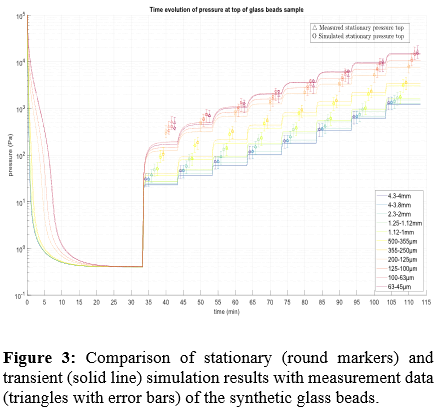Modelling of gas flow through porous granular media
- Space Research Institute, Austrian Academy of Sciences, Graz, Austria
Abstract
To validate the physical model used to describe gas flow through porous, granular media in recent experiments [1], we conducted a finite element analysis (FEA). The main parameters of a sample, such as gas permeability, Knudsen diffusion coefficient and porosity were determined from the experiment and used as an input for the simulations, with the aim of replicating the pressure evolution (measured quantity) depending on external gas flow. While the results matched well for samples with large and spherical grains, the deviations were significant for materials with small and irregularly shaped grains. An improvement of the model could be achieved with complementary simulation methods and a more detailed analysis of the samples.
1. Introduction
In the past decades, multiple cometary space missions (e.g. Deep Impact and Rosetta) have provided us with better data and understanding of the solar system’s primordial objects. The most recent project is a cooperation of six European institutions, called “Cometary Physics Laboratory (CoPhyLab)” and has already produced a plethora of results (see webpage https://cophylab.space/index.php?id=27). In this work we investigated gas flow through porous media with a simulation approach, in order to compare it with the experiment and validate its physical model.
2. Experiment
The basis and motivation of this work was the experiment performed by [1] (see Figure 1), where the gas flux through a set of artificial and natural porous materials was analysed. To describe the flux J [mol∙m-2∙s-1] of dry air in the given pressure range, a combination of viscous flow and free molecular diffusion was chosen as the physical model:
The gas permeability B0 (viscous flow) and Knudsen diffusion coefficient DK (molecular diffusion) are the main parameters which describe a sample’s ability to allow gas to flow through it. They were determined by measuring the steady state pressure difference across the inlet and outlet of the sample for different gas flux levels. The porosity of the materials was measured through packing experiments.
3. Simulation
Since the physical model describes the gas flow on a macroscopic level, with the main parameters being determined as average values across the whole sample, a FEA is the ideal method. The simulations were computed with the software “COMSOL Multiphysics®”, in which the sample was modelled as a cylinder (see Figure 2). The built-in physics module “Darcy’s Law” was selected to provide the governing equations and all input parameters were taken from the measurements (sample dimensions, B0, DK, porosity, viscosity etc.). In stationary studies, the pressure at the sample outlet and the inward mass flux of the measurements were defined as boundary conditions for the simulation, with the pressure in the rest of the sample being the free variable. For transient studies, the empty volumes of the vacuum chamber, as well as the pressure dependent performance characteristic of the pump were taken into consideration to be able to compare the dynamic process. Furthermore, variation studies of the main parameters were carried out to investigate their individual influence on the pressure evolution. Boundary effects such as the facilitation of gas flow due to lower porosity at the container wall or opening of channels in the sample, or impediment due to the holding sieve, were also analysed by adapting the material parameters for the respective boundary layers.
4. Results
For the comparison of stationary simulation results with those of the experiment, the measured pressure at the inlet face of the sample was taken as a boundary condition and for transient simulations also the outlet face pressure (see Figure 3 for an exemplary comparison of results). The deviations were relatively small for synthetic material with large grain sizes (i.e. glass beads with a diameter above 200 µm). However, for smaller grain sizes and natural materials the discrepancies were quite large (up to 35%) and featured no apparent correlation regarding the amount of gas flow.
Regarding parameter variation studies, it is important to note that the creation of physical samples where only one parameter varies is very difficult, because many of the parameters are directly or indirectly coupled with each other. Nevertheless, the results indicated that in regimes of low B0 and DK, as is the case for small grain size samples, a variation of either parameter has a large influence on the pressure evolution. This is particularly important when considering measurement and regression errors.
When boundary layers were added for the analysis of boundary effects (higher permeability and diffusion at the cylinder wall or in a channel), most of the gas flowed through it and the pressure difference across the sample was minimal. Deviations between simulations with and without the holding sieve, manifested themselves as temporary spikes when the gas flow was increased, with steady state differences below 2%.

5. Summary and Outlook
The results indicate that the applied model is well consistent with the measurements of homogenous samples (e.g. synthetic materials with large, spherical grains). However, in the case of small and irregularly shaped grains, the material’s anisotropy could explain the discrepancies. To improve the existing model, it is necessary to analyse the physical samples on a smaller scale and better understand the interdependencies of the governing parameters. This can be achieved by creating virtual samples and using alternative simulation methods (i.e. Monte Carlo), which work on a microscopic scale.
6. Acknowledgements
This work was carried out in the framework of the CoPhyLab project funded by the D-A-CH programme (GU 1620/3-1 and BL298/26-1/SNF 200021E 177964/FWF I 3730-N36).
References
[1] M. Schweighart, W. Macher, G. Kargl, B. Gundlach, H. L. Capelo, Viscous and Knudsen gas flow through dry porous cometary analogue material, Monthly Notices of the Royal Astronomical Society, 2021;, stab934, https://doi.org/10.1093/mnras/stab934
How to cite: Laddha, S., Kargl, G., and Macher, W.: Modelling of gas flow through porous granular media, European Planetary Science Congress 2021, online, 13–24 Sep 2021, EPSC2021-42, https://doi.org/10.5194/epsc2021-42, 2021.

